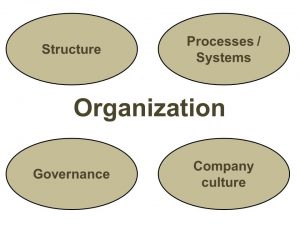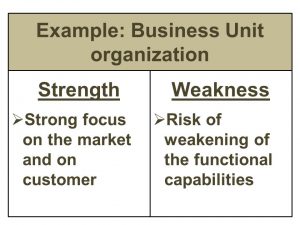The topic of organizational design is very often focused on organizational structure. This does not make justice to the true scope of this field, which covers in reality 4 equally important areas: structure, processes, governance and culture. I want to outline here how and why we should take a holistic perspective on these topics when we address organizational issues.
Organization covers 4 areas:
The structure of the organization defines the reporting lines between employees. The structural design options are outlined in the following paragraph. The number of layers in the organization impacts the span of control that managers have.
Processes and systems define how people interact and how information is shared in the organization.
Governance defines the way decisions are taken.
The company culture includes the norms and values that impact the interpretation employees will make of certain facts or of certain situations. This may include the explicit norms as well as the unwritten rules of the game (see my article on cultural change for more details on these aspects).

the structure of the organization
We know there are different ways to structure an organization. The most common options are the functional, the geographical and the Business Unit structure.
The Business Unit structure follows usually a market or consumer segmentation. BUs cluster products that are relevant for specific segments. This structure is obviously most relevant for diversified companies that operate in multiple market segments. A combination of these organizational options is possible in form of a matrix organization. Here two of these options are combined. This leads obviously to more complex organizational configurations.

What is important to point out is that there is no configuration that is better as such. Instead, each one of these options has its specific advantages and downsides. There is no optimal configuration. The decision to select one model should be driven by a clear understanding of the specific strength and weaknesses of the selected option. The right organization is one that best responds to the market requirements.

The interesting observation is that the strength of one configuration are often the weaknesses of the other model., as the following example will illustrate.
example : Functional VS Business Units
Let’s take a look at two of the most common organizational options, the functional versus the Business Units organization. In a functional organization the company is structured along its key functions such as sales, marketing and production. These functions are headed up by an executive leader who sits in the highest governance body.
In the Business Units configuration we have the leaders of certain business lines sitting at the executive level. Usually, the functional line (especially sales and marketing) is in that case at the second organizational level reporting to the Business Units heads.

The strength of the Business Units model is that is allows to have market and customer focus at the highest level of the organization which could allow a company to best address these requirements.
The downside is that the functional teams are more fragmented. You will for example find marketing teams sitting in each BU without a leader who is federating them all. This can lead over time to a weakening of the functional capabilities because each of these marketing teams in the BUs will progressively drift apart and develop their own approaches. Also, it will be more difficult to recruit top marketing talents, because the top marketing job is not sitting at the executive level.
Assessing strengths and weaknesses of each design option
The strength of one option is the weakness of the other model. There is no optimal structure because each one has a certain profile of strengths and weaknesses.
That is of course also true for the more complex models, such as the matrix organization. Here the complexity itself is a downside, even if it allows combining some of the strength of the two organizational dimensions it is built of.
it is therefore important to understand the upsides and the downsides of each model. This allows making the right structural choices, but in addition, it allows using counterbalancing mechanisms to neutralize the specific weaknesses for the structure we have selected.
Counterbalancing mechanisms
In addition to the structural aspects, we have to consider the processes as well as the governance and cultural aspects. The good news is that these other aspects can help to counterbalance some of the downsides of the selected structural options.

in the BU example we discussed above, we saw the risk of a progressive degradation of marketing skills. We could implement a cross-BU Marketing training program to maintain a high sills level in this function. That could also allow promoting common ways of working (e.g. a common brand planning approach). We could even create a Marketing Academy with high quality programs that would help attract top talents.
Finally, we could task one of the BU Marketing heads to lead a cross-BU Marketing talent management program to ensure we develop strong successors. Her or his responsibility could be to promote the career development of marketing talents across the organization and to ensure that the company. Facilitating the mobility of talents and ensuring their development could help avoid that these capabilities degrade.

Summary
Organizational design requires a deep understanding of the specifies of each possible configuration. Understanding their pros and cons in view of the business requirement of our organization should be the starting point.
Selecting the option that is best suited to respond to the market needs should be the second step.
Thirdly, all 4 organizational dimensions (structure, processes, governance and culture) should be used in a systematic way. Processes, governance and culture can be used to counterbalance any of the inherent weaknesses of the selected organization structure. Process design, the definition of governance and adjusting our company culture should therefore go hand in hand with the implementation of a new structure.
Unfortunately companies are very often still far away from that black belt approach. Short term focused and isolated reorganization measures may show some short term benefits but usually lead to a longer term reduction of effectiveness.
This shows how important it is to take a holistic perspective on organizational design, including processes, governance and ways of working in addition to the structural aspects. This allows implementing counterbalancing mechanism to address in a systematic way some of the downside of the selected structural option.
Make counterbalancing mechanisms an integral part of your organizational design.
More information in my book:
Sven Sommerlatte : Successful Career Strategy – An HR Practitioner’s Guide to Reach Your Dream Job (Springer, June 2023). ISBN: 978-3-662-66790-3
